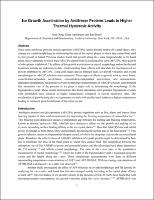Please use this identifier to cite or link to this item:
https://hdl.handle.net/20.500.12202/9811Full metadata record
| DC Field | Value | Language |
|---|---|---|
| dc.contributor.author | Drori, Ran | - |
| dc.contributor.author | Deng, J. | - |
| dc.contributor.author | Apfelbaum, E. | - |
| dc.date.accessioned | 2024-02-13T21:18:40Z | - |
| dc.date.available | 2024-02-13T21:18:40Z | - |
| dc.date.issued | 2020 | - |
| dc.identifier.citation | Deng, J., Apfelbaum, E. & Drori, R. (2020). Ice growth acceleration by antifreeze proteins leads to higher thermal hysteresis activity. The Journal of Physical Chemistry B, 124(49), 11081-11088. | en_US |
| dc.identifier.issn | 1520-5207 | - |
| dc.identifier.uri | https://pubmed.ncbi.nlm.nih.gov/32472617/ | en_US |
| dc.identifier.uri | https://hdl.handle.net/20.500.12202/9811 | - |
| dc.description | Research article / Open access | en_US |
| dc.description.abstract | Since some antifreeze proteins and glycoproteins (AF(G)Ps) cannot directly bind to all ice crystal planes, they change ice crystal morphology by minimizing the area of the crystal planes to which they cannot bind until crystal growth is halted. Previous studies found that growth along the c -axis (perpendicular to the basal plane, the crystal plane to which these AF(G)Ps cannot bind) is accelerated by some AF(G)Ps, while growth of other planes is inhibited. The effects of this growth acceleration on crystal morphology and on the thermal hysteresis activity are unknown to date. Understanding these effects will elucidate the mechanism of ice growth inhibition by AF(G)Ps. Using cold stages and an infrared laser, ice growth velocities and crystal morphologies in AF(G)P solutions were measured. Three types of effects on growth velocity were found: concentration-dependent acceleration, concentration-independent acceleration, and concentration-dependent deceleration. Quantitative crystal morphology measurements in AF(G)P solutions demonstrated that the adsorption rate of the proteins to ice plays a major role in determining the morphology of the bipyramidal crystal. These results demonstrate that faster adsorption rates generate bipyramidal crystals with diminished basal surfaces at higher temperatures compared to slower adsorption rates. The acceleration of growth along the c -axis generates crystals with smaller basal surfaces at higher temperatures leading to increased growth inhibition of the entire crystal. | en_US |
| dc.description.sponsorship | Acknowledgments The authors thank Prof. Peter Davies for sharing LpAFP and AFPIII-QAE samples, Dr. Konrad Meister and Prof. Arthur DeVries for sharing the AFGPs and AFPI. The authors also thank Nechama Dembitzer and Nicole Soussana for data collection. | en_US |
| dc.language.iso | en_US | en_US |
| dc.publisher | Original Publication: Washington, D.C. : American Chemical Society, c1997- | en_US |
| dc.relation.ispartofseries | The Journal of Physical Chemistry B;124(49) | - |
| dc.rights | Attribution-NonCommercial-NoDerivs 3.0 United States | * |
| dc.rights.uri | http://creativecommons.org/licenses/by-nc-nd/3.0/us/ | * |
| dc.subject | Antifreeze proteins | en_US |
| dc.subject | Ice | en_US |
| dc.subject | Acceleration | en_US |
| dc.subject | Adsorption | en_US |
| dc.subject | Crystallization | en_US |
| dc.subject | Freezing | en_US |
| dc.subject | bipyramidal crystal | en_US |
| dc.subject | antifreeze proteins and glycoproteins (AF(G)Ps) | en_US |
| dc.title | Ice growth acceleration by antifreeze proteins leads to higher thermal hysteresis activity. | en_US |
| dc.type | Article | en_US |
| dc.contributor.orcid | 0000-0002-6436-5602 | en_US |
| local.yu.facultypage | https://www.yu.edu/faculty/pages/drori-ran | en_US |
| Appears in Collections: | Stern College for Women -- Faculty Publications | |
Files in This Item:
| File | Description | Size | Format | |
|---|---|---|---|---|
| Drori 2020 OA ice-growth-acceleration-by-.pdf | 648.01 kB | Adobe PDF |  View/Open |
This item is licensed under a Creative Commons License

